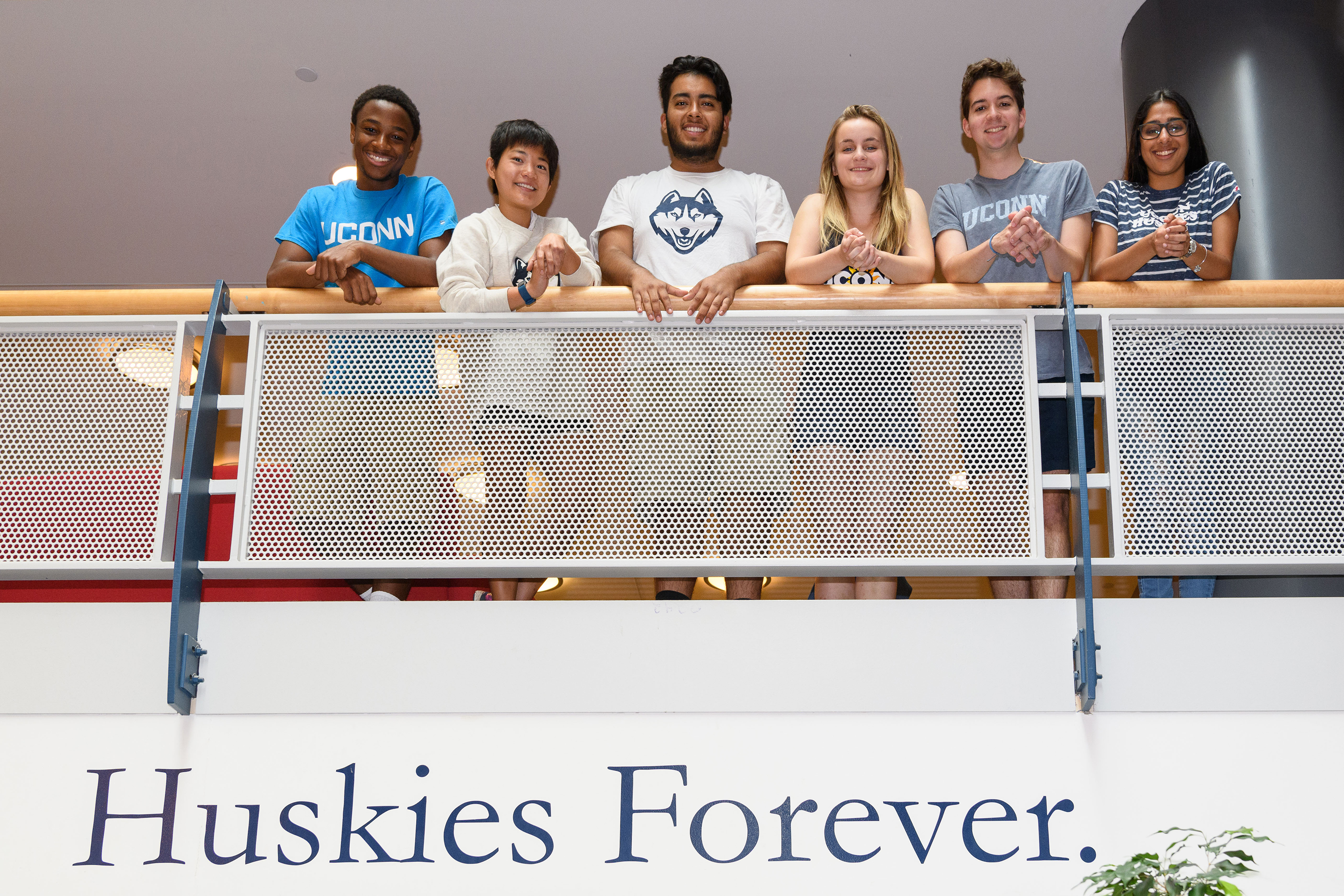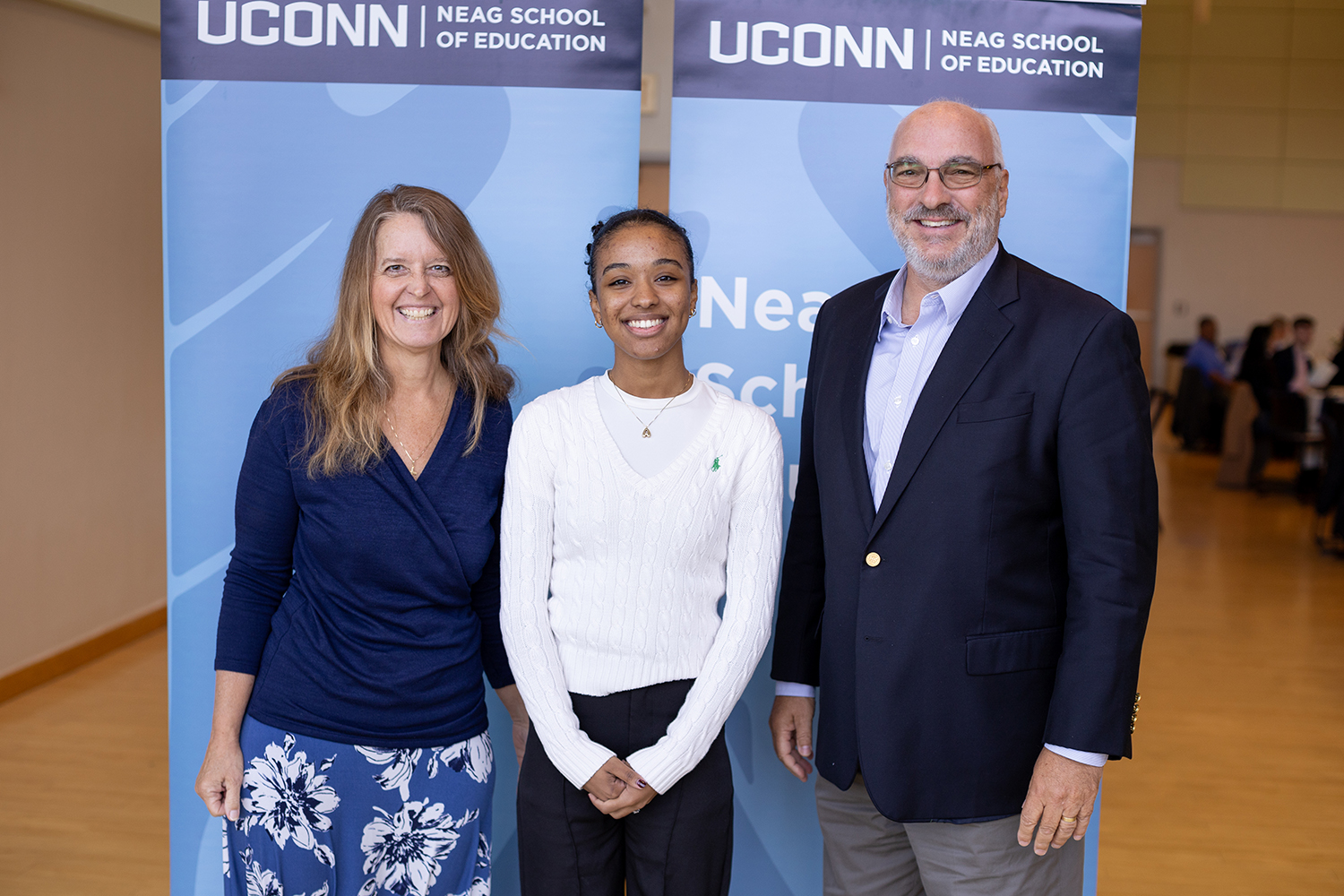UConn’s investments in its regional campuses are drawing record numbers of talented new freshmen to those locations, joining their highly accomplished peers who are coming this week to UConn Storrs to begin their college careers.
Almost one-third of UConn’s new freshmen this year chose to enroll at one of the four regional campuses, up from about one-quarter of the freshmen in fall 2015. The growth is particularly evident at UConn Stamford, where new student housing that opened last week helped propelled the enrollment of new freshmen by 50 percent over last year.
Excitement over the new downtown UConn Hartford campus, which opened Wednesday, also has helped drive up freshman enrollment there by about 14 percent, while Waterbury figures are up by about 24 percent, and Avery Point is holding steady.
[UConn] already feels like home. — Olivia Knuth '21 (CAHNR)
At Storrs, the 3,650 new freshmen represent a smaller class than last year by design, reflecting state budgetary constraints that have resulted in UConn’s decision to slow growth there rather than allow class sizes to grow too large.
Overall, UConn will welcome about 5,230 new freshmen and 1,100 transfer students across all campuses this fall, according to preliminary figures. The overall undergraduate student body will number about 23,854, with about 19,200 of those students based at Storrs.
The majority of students begin moving in Friday and throughout the weekend at Storrs and Stamford, and classes begin Monday.
“We’re proud to welcome such an extraordinary group of students to our campuses,” President Susan Herbst said. “The UConn class of 2021 is defined by their exceptional talent, ambition, and diversity. Our combination of academic strength and economic value continues to make UConn a top choice for outstanding students from throughout the state, nation, and world.
“This semester also features two terrific UConn firsts: new and returning students in Hartford are the very first to attend classes at our new downtown Hartford campus, and many Stamford students are the first to move into our new student residence hall in Stamford,” she added. “Both are generating incredible pride and enthusiasm.”
Students have responded to the addition of housing in Stamford, and the opening of the new campus in downtown Hartford, in a very positive way. — Nathan Fuerst
Bryant Cuapio ’21 (SFA), an incoming freshman and digital media design major from New Haven, applied to all of Connecticut’s state schools and some private colleges, but found his decision was easy: UConn Stamford offered everything he wanted and more.
He’s one of about 560 new freshmen at the bustling campus in downtown Stamford, where expanded programs in business and digital media have helped drive enrollment increases, along with the new student housing.
“I knew I wanted to stay in Connecticut, and I’ll have so many more opportunities at UConn than anything I’d get anywhere else,” said Cuapio, who plans to commute from home to UConn Stamford in his first year, then live in the UConn Stamford residence hall as a sophomore.
About 73 percent of UConn’s incoming freshmen are Connecticut natives, the highest number in recent years.
Overall, about 80 percent of UConn’s undergraduate student body hails from Connecticut, a figure that has held steady for about the past decade and is not expected to change in the foreseeable future.
“UConn has once again attracted a record number of Connecticut high school seniors to apply across all of UConn’s campuses, and has done so in the face of a declining number of high school graduates in the state,” said Nathan Fuerst, UConn’s assistant vice president for enrollment and director of undergraduate admissions.
“Momentum in student interest is particularly notable across our regional campuses, where students have responded to the addition of housing in Stamford, and the opening of the new campus in downtown Hartford, in a very positive way,” he said.
Thirty-five percent of the freshmen at Storrs come from minority backgrounds, not including those who came to UConn from other countries.
Academically, their credentials are also impressive: UConn attracted a record 184 valedictorians and salutatorians this year across all campuses, and will add a record 549 freshmen and transfer students to its Honors Program.
More than half – 54 percent – of the incoming freshmen at Storrs were in the top 10 percent of their graduating high school classes, and 89 percent were in the top 25 percent.
The mean SAT for the incoming class is 1294. It is not possible to compare incoming students’ SAT scores against those of previous classes because that nationally used assessment test has changed substantially, and it is no longer an apples-to-apples comparison from one year to the next.
And among students who took the ACT – another assessment test more often used in the Midwest than the Northeast – the incoming UConn freshmen’s average score of 28.7 is a new high, up from 27.3 five years ago.
As in previous years, the Class of 2021 is also diverse both in culture and geography, with freshmen coming from 162 of Connecticut’s 169 towns and cities.
“I wasn’t sure what to expect, but it’s a really friendly campus and it was easy for me to get around it pretty quickly after I got here,” said Ryan Wellington ’21 (BUS), an incoming Honors Program student and accounting major from Bloomfield who took two classes under the five-week First Summer program at Storrs to get a head start on earning credits.
Everett Grethel ’21 (SFA), a digital media design major from Lyme, said he felt welcome and valued at UConn even before stepping foot on campus for his summer courses.
“A lot of schools ask, ‘What can you do for us?’ when you’re applying, but at UConn it’s been, ‘We want to help you do well here,’” Grethel said.
All of this year’s incoming freshmen have already crossed a major hurdle in their college careers by being offered spots in UConn’s Class of 2021, since they were competing in field of about 36,900 applications.
Olivia Knuth ’21 (CAHNR), an animal science major from West Hartford, said she looks forward to getting involved in groups and organizations such as intramural soccer, the Rainbow Center and Cultural Centers, and Chinese students’ groups.
“I was worried that I’d get on campus and kind of float for the first six months until I found my place,” she said, “but it already feels like home.”


